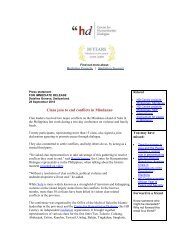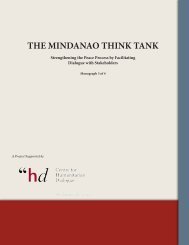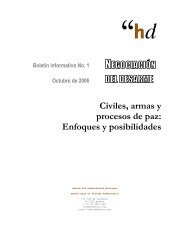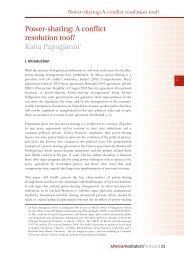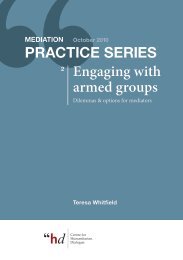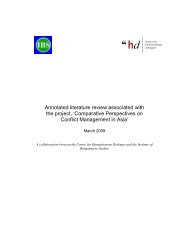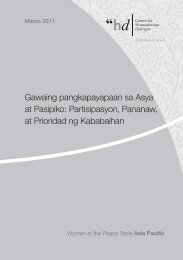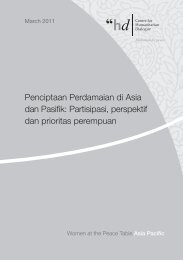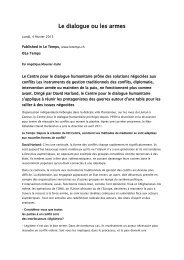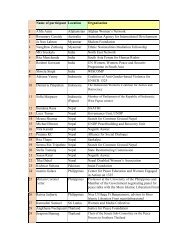Pagpati'ut - Centre for Humanitarian Dialogue
Pagpati'ut - Centre for Humanitarian Dialogue
Pagpati'ut - Centre for Humanitarian Dialogue
You also want an ePaper? Increase the reach of your titles
YUMPU automatically turns print PDFs into web optimized ePapers that Google loves.
Silangkan and Punay Poblacion. On the other hand, there is an existing<br />
<br />
<br />
<br />
the current Barangay captain to per<strong>for</strong>m his duties and <strong>for</strong> services to be<br />
facilitated.<br />
The other three (3) Barangays studied are still considered fragile since the<br />
<br />
settlement of the parties did not prevent a violent act from being carried<br />
out, and two children were the most recent and un<strong>for</strong>tunate victims of this<br />
violence.<br />
This is somehow validated by the response of respondents – Barangays<br />
Sionogan, Silangkan and Punay Estino seem to experience less of the<br />
<br />
Pujungan and Niangkaan (See Table 13). This also translates to the<br />
perception of fear/safety of the communities. In Table 15, respondents<br />
from Barangays Sionogan, Silangkan and Punay Poblacion are more<br />
<br />
day. Contrast this with respondents from Barangay Masjid Pujungan, a<br />
<br />
the day and 55.2% at night (See Table 15).<br />
P R E S E N T A T I O N & A N A L Y S I S O F F I N D I N G S<br />
The freedom of movement felt by respondents from Barangays Sionogan,<br />
Silangkan and Punay Poblacion suggests a relatively safer and more<br />
secure environment, allowing people to go about their daily lives. A safe<br />
<br />
the freedom to pursue daily activities without fear of politically motivated,<br />
persistent, or large-scale violence”. (United States Institute of Peace,<br />
n.d.) 28 In other words, in these communities, lives are not disrupted and<br />
families are not displaced.<br />
Noticeably, in these three Barangays (Sionogan, Silangkan, and Punay),<br />
there is an observed movement towards rules-based and communitybased<br />
mechanisms, and a clear decline in reliance on <strong>for</strong>ce.<br />
28 United States Institute of Peace, Guiding Principles <strong>for</strong> Stabilization and Reconstruction (The<br />
Web Version), accessed at http://www.usip.org/files/GP_46-70_Safe_Secure_Environment.pdf<br />
43



